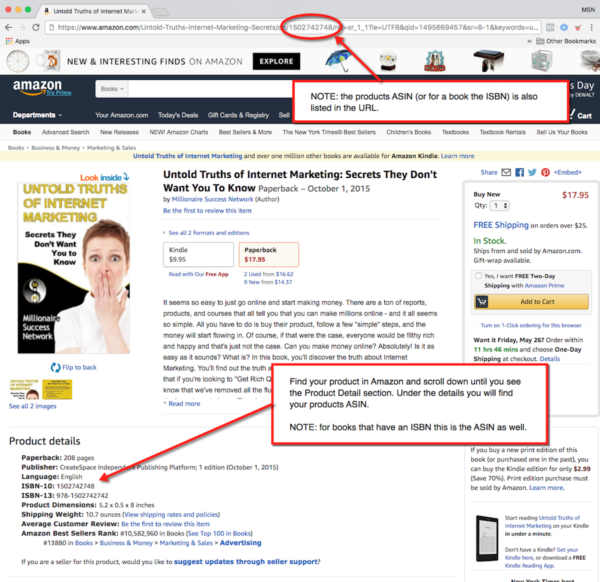
Wishing You a Peaceful, Prosperous
and Success Filled New Year!
Inspired Living by
Millionaire Success Network

Inspired Living

Wishing You a Peaceful, Prosperous
and Success Filled New Year!
Inspired Living by
Millionaire Success Network
When it comes to links, which one of these would you rather have to deal with when setting up a link to an Amazon product in your web site code?
https://www.amazon.com/dp/1502742748/?tag=millisuccenet-20
Although both links will get you to the same product the second one is definitely much easier to work with.
In addition to being easier to work with, using an Amazon Affiliate Link is a good way to make some extra money when selling your products. Why? Because every time someone buys a product using one of your Affiliate Links, Amazon will pay you a small affiliate fee or commission. Therefore, when adding Amazon products to your website you will always want to use an Amazon Affiliate Link.
Once you understand the structure of an Amazon Affiliate Link it will be really easy to create them in the future, so let’s breakdown the link structure into three key parts as shown in the diagram below.

Part 1: is simply the first portion of an Amazon URL and is the same for all affiliate links – https://www.amazon.com/dp/
Part 2: is the ASIN or Amazon Standard Identification Number of a product and is unique for all products – 1502742748
Part 3: is a tag parameter followed by an Amazon Tracking ID – /?tag=millisuccenet-20
Before you can find your Amazon Tracking ID you have to logon to your Amazon Affiliate Program account.

After you have logged in you should be taken to your Amazon Associates home tab. At this point you will want to mouse-over your Amazon Login ID and slide down to select the “Manage Tracking IDs” options to take you to the Tracking ID page as shown below.

At this point you should see all of the Tracking IDs that you’ve created or at least a default one. Write down or Copy & Paste the Tracking ID you want to use for your Affiliate Link into a note or temporary file (e.g. millisuccenet-20.)
Now that you know your Amazon Tracking ID you have to find the ASIN of the product you want to create an Affiliate Link for. Note: for books the ASIN may be listed as the ISBN under the product details, as shown in the image below.

Write down or Copy & Paste the ASIN you want to use for your Affiliate Link into a note or temporary file (e.g 1502742748.)
Now that you have all the components to create your Amazon Affiliate Link all you have to do is assemble them and you are done. Just replace the ASIN number and TRACKING-ID in the default link structure below with your specific items and you are all set to go.
https://www.amazon.com/dp/ASIN/?tag=TRACKING-ID
Example ASIN = 1502742748
Example TRACKING-ID = millisuccenet-20
Resulting Amazon Affiliate Link is:
https://www.amazon.com/dp/1502742748/?tag=millisuccenet-20
The best part about this is that it will not just work for your products, it will work for ANY Amazon product that you want to be an affiliate for. Pretty cool!
The last thing you want to do is create an affiliate link for a product that doesn’t work. Few things stink more on the web than clicking on a link that doesn’t work or takes you to something other than what you wanted. Fortunately, Amazon provides a Link Checker tool that allows you to validate the Affiliate Links you create.
From within your Amazon Associates account you will want to mouse-over the “Tools” menu option, then slide down and click on the “Link Checker” option as shown below.

At this point you will need to Copy & Paste the Amazon Affiliate Link you created into the URL Link Entry Field and then press the “Check Link” button. If all goes well and you created a valid link, Amazon will return the message “Success. The link tags to a valid tag or sub-tag for your Associate ID” in green under your link.
You can now use this Amazon Affiliate Link you created on your website, in an Email, a blog posting, or any other way you can think of. And the best part about it is that every time someone clicks on your affiliate link and purchases the item from Amazon you are going to earn a commission.
Making a little “extra” income just got a little bit easier.
To Your Success!
When it comes to colors things aren’t just black and white. In fact some would even argue if those are colors, but that discussion is for another day. For now, we’re just going to talk a little about the color wheel and hopefully give you enough coloring tips to make your adult coloring journals amazing works of art.
The color wheel identifies three types of colors: primary, secondary, and tertiary. Primary colors (Red, Yellow, and Blue – P in the color wheel) are true colors from nature and are used to create all other colors. Secondary colors (Orange, Green, and Purple – S in the color wheel) are created by mixing two primary colors. Tertiary colors (Red-Orange, Orange-Yellow, Yellow-Green, Green-Blue, Blue-Purple, Purple-Red) are created by mixing adjacent primary and secondary colors.
colors (Red, Yellow, and Blue – P in the color wheel) are true colors from nature and are used to create all other colors. Secondary colors (Orange, Green, and Purple – S in the color wheel) are created by mixing two primary colors. Tertiary colors (Red-Orange, Orange-Yellow, Yellow-Green, Green-Blue, Blue-Purple, Purple-Red) are created by mixing adjacent primary and secondary colors.
Half of the color wheel has “Warm” colors that are said to reflect passion, happiness, enthusiasm, and energy. The other half of the color wheel has “Cool” colors, which are said to give a sense of calm or professionalism. And finally we have the complementary colors. Complementary colors are directly opposite each other on the color wheel (Red – Green, Orange – Blue, Yellow – Purple, etc.)
Now in color theory you will also find these terms:
By the way, it’s color theory that also defines the cool and warm colors we talked about earlier.
Once you have a basic understanding of the color wheel and see how different color combination are formed, you can use one or more colors to create a color scheme.
Keep in mind that in almost all cases, when choosing a color scheme, all colors are altered and combined to soften their impact and create a mood.
The cool thing about color is that what you like and we like, and everyone else likes, is not going to be the same. And since the adult coloring journal your drawing in is all yours, we suggest that you draw from your own experiences and decide on the colors you want to use for each of your drawings.
However, we do know that most people prefer to use colored pencils when coloring their drawings. One reason is because colored pencils offer a lot of versatility, enabling you to easily blend and shade colors. Another reason is that they typically don’t have the bleed through problem that felt-tip markers have. Of course you also have the option of using crayons, chalks, and paints. Although some of those tend to get a little messy and require drying time. WARNING: if you’re going to use something that will bleed through, make sure you put something in between your pages and also realize that you’ll probably not be able to use the item on the back side of the page you just used.
Our final coloring tip relates to shading. Shading allows you to add “dimension” to your drawings. Dimensions can be created by layering your colors or mixing different colors along the edges or corners of your drawing. Shading can also be added with dots or fine black lines before coloring with your pencils, or by using a darker color over a lighter area of the same color.
When all is said and done, or colored, however you color in your drawings and whether you stay within the lines or not, is total up to you. Whether you use it to express how you’re inner most feelings, or to release built up tension from a stress filled day, or just to color, your adult coloring journal is yours and yours alone. Each and every drawing you color is your master piece.
We hope you enjoy your journal and if you’re looking for more journals, or just other books in general, checkout our other books when you have a chance. And don’t forget to visit our coloring downloads page for some extra special stuff too!
You’ve come up with an awesome idea, developed a great product, put together an amazing business/marketing plan, and built the most beautiful eCommerce store this side of the Mississippi. Unfortunately your sales figures are far from what you envisioned, in fact not even close, and your conversion rate is dismally low. What could possibly have gone wrong? Could it be that you forgot that building your prospective eCommerce customer trust is somewhat key to being successful online?
Despite global eCommerce sales growing by 25% in 2015 (projected to eclipse $3.5 trillion within the next five years); the average consumer still sees online shopping as a stigma-tainted view of substantial risk and uncertainty. Perhaps their view is the result of the endless security thefts of customer data from corporations reported in the media, and the resulting free credit monitoring services offered to them to protect their identity.
Regardless of why consumers view online shopping as risky, understanding, addressing and helping overcome these inherent consumer fears of eCommerce is often the key towards altering their purchasing behavior, and ultimately garnering success for your eCommerce business. Let’s take a look at 5-key steps to help you build your prospective eCommerce customer trust.
The first key to developing a successful eCommerce online experience is delivering a well-designed site. Unfortunately, many sites have overbearing advertisements, suffer from poor design with improperly positioned graphics, and consist of impossible to navigate menus.
Chances are you’ve arrived at one of these proverbial nightmares of an eCommerce store recently. Not only did it lack any credibility, it was the epitome of a bad user interface (UI). The following two questions will quickly determine your level of customer trust for sites like this:
1: As a consumer, do you trust such a store enough to make an online purchase?
2: As a business owner, can you objectively see the negative UI eCommerce experience you’ve created for the customer?
Understanding potential UI problems and knowing how to eliminate them is the first step in creating an online store that builds prospective eCommerce customer trust. Creating a UI that is consistent and easy to use is key to building not only a visually pleasing experience, but a happy one as well. Here are a few things to think about when developing your store’s UI:
Today’s online world is filled with more security breaches than you’ll ever imagine. Barely a month goes by without hearing of another major incident concerning credit card fraud or identity theft that impacts not just thousands, but millions of individuals.
It’s no wonder online consumers are hesitant to share credit card details and other personal information online, especially older individuals who are not comfortable with technology. And those customers who do purchase online are often naive; they setup online store accounts with easy to guess IDs and passwords. Regardless of how secure your site is you can’t prevent a break-in, if your customers don’t follow some simple rules to keep their login information hard to hack.
Failure to protect your customer’s personal information will immediately set back any progress you’ve made in building your prospective eCommerce customer trust. One of the easiest ways to not fail at doing this is to use only well-known payment processing software and/or services. Although nothing is hacker proof, using something that is created by people familiar with financial processing will be much more secure than trying to develop something on your own.
Additionally, any communications that you have with your customers that require sensitive information to be exchanged must be done using a Secure Sockets Layer (SSL) implementation. If the communication link isn’t secure, it doesn’t really matter if the data is stored securely or encrypted on the backend.
Finally, have a clear and concise privacy policy available on your eCommerce site. Don’t give away any secrets, but at a minimum explain how you value your customers and take appropriate measures to protect their information. Let them know what you will do in the event of a data breach and how they can contact you, if they believe their information has been compromised. Although most people will never read your policy pages, having them will allow those customers who do to rest assured (and spend) knowing that their information is safe in your hands.
When is the last time you went window shopping, only to walk out of the store with both arms full of shopping bags? The physical ability to touch and feel, see and taste, will always remain the key factor of impulse buying. Brick-and-mortar stores take care to arrange items to exploit these impulse buying instincts. As well as, having their sales associates ask those final checkout questions to get you to make that one last purchase on your way out the door.
Replicating the physical process of shopping in the online digital world is key to increasing your online eCommerce sales. Having high quality images that show multiple views of a product, with a zoom function, can go a long way in getting the online shopper to experience the “physical” nature of an item in the digital world.
Also, leaving the wondering (online browsing) in the digital world up to the visitor can quickly lead to lost sales as visitors jump from product to product or worse site to site. Therefore, including links to secondary items that complement the purchases customers make is critical and just one way to setoff that impulse buying trigger.
Unless you have the look of an “Ogre” or smell like a “Donkey” you’ve probably experience at least one, if not many, of those annoying “Shadowy” sales associate experiences. You know the ones; where the salesperson is up your butt the second you walk in the door, asking question after question, and knowing no limits to your personal space as you browse up and down the aisles. Yes, those joyful experiences.
On the flip side you’ve also probably faced the even worse experience of being able to find absolutely “No” salesperson in the entire store when you’re looking for just that one item and are already late for the most important event of the century. Either way, finding the right level of “Nth Time” help can make or break the in store shopping experience. Well guess what? The same is true for the online eCommerce shopping experience as well.
Yep, it’s true. Even though online shopping is usually an experience involving only the customer and their computer, building your prospective eCommerce customer trust requires the right “Nth” level of hand-holding when you’re not there to hold their hand.
Whether it’s displaying those helpful hint “extra” items that trigger an impulse buy, or popping up a “chat” link to help what appears to be a lost visitor just aimlessly browsing, it’s important to be able to service and assist customers that come to your online store. Comprehensive FAQs can go a long way in helping the independent customer, while clear and concise contact links can make the day of an occasional online shopper.
If you’ve never had to return anything, you are one of the lucky few. And if you have returned something it’s highly likely that the return process didn’t go too well, especially if you bought the item being returned online.
A comprehensive, well-thought out returns policy that won’t bankrupt your business and will do just about anything to satisfy your consumer will go a long way towards reducing purchasing indecisions. Providing the online shopper with a simple safety net of being able to return products that just aren’t what they expected or have issues with, will really build long-term prospective eCommerce customer trust like you never thought possible.
It’s one thing to have your return policies published on your site and clear links to them, it’s another thing to make sure your customer support staff follows through with them when the customer calls. Even the worst initial product experience can turn a one and done customer into a repeat buyer, if customer support makes the return process a no-brainer, zero cost experience for the frustrated buyer.
No two businesses are alike and no two online buying experiences are usually the same, even when made on the same site. There is no magic wand or silver bullet that will increase customer conversions and result in more of your products being bought.
Only by delivering an exceptional buying experience and eliminating the fears of the eCommerce consumer will you build trust with prospective customers. The road to success is never easy, but thinking through the process and building that trust with your prospective customers will go a long way at reducing any speed bumps you encounter down the road.

“Celebrate the… Red, White & Blue!”
Happy 4th of July
Inspired Living by
Millionaire Success Network